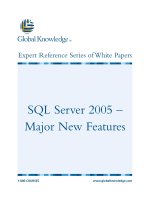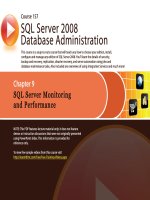SQL Server 2005 Database Administration potx
Bạn đang xem bản rút gọn của tài liệu. Xem và tải ngay bản đầy đủ của tài liệu tại đây (2.38 MB, 166 trang )
SQL Server 2005
Database Administration
Agenda
• Introduction
• Installation
• Data Storage Architecture
• Database Physical Architecture
• Tuning and Monitoring
• Security
• High Availability
• Backup-Restore
• Administration Overview
SQL Server 2005
SQL Server 2005 – Components Overview
Relational Database
Engine
.NET CLR
Integration Services
SQL Server Agent
Analysis Services
Reporting Services
Notification Services
Replication
SQL Server 2005
SQL Server 2005SQL Server 2005
SQL Server 2005
Service Broker
SQL Server 2005- Components
SQL Server 2005 – Relational Database Engine
Database Engine
• The primary component of SQL Server 2005
• The Online Transaction Processing (OLTP) engine for
SQL Server
• Responsible for the efficient storage, retrieval, and
manipulation of relational and Extensible Markup
Language (XML) formatted data
• Highly optimized for transaction processing
SQL Server 2005 – Analysis Services
Analysis Services
• Provides Online Analytical Processing (OLAP) and Data
Mining functionality
• Analytical processing done through multidimensional
data structures containing de-normalized and
aggregated data, often from diverse data sources
• Data Mining allows analysis of large quantities of data
for relationships and patterns
SQL Server 2005 – Integration Services
Integration Services
• Supports data extraction and loading to and from
heterogeneous data sources
• A complete change from its predecessor, Data
Transformation Services (DTS)
• Supports data extraction and loading to and from
heterogeneous data sources
SQL Server 2005 – Reporting Services
Reporting Services
• Provides solution for designing, deploying, and
managing flexible, dynamic Web-based reports
• Can pull information from various data sources
• Implemented as a Web service
• Supports user defined adhoc report
SQL Server 2005 – Notification Services
Notification Services
• Helps building applications that support the generation
and sending of data-driven notifications
• Notifications are personalized, timely messages that
can be sent to a wide range of devices according to
subscriber preference
• Enables sending critical information to customers,
partners, and employees
SQL Server 2005 – SQL Server Agent
SQL Server Agent
• Essential tool for automating database administration
• Executes scheduled administrative tasks through jobs
• Jobs can perform various database and non database
activities
SQL Server 2005 – Service Broker
SQL Server Service Broker
• Is a new technology in Microsoft SQL Server 2005
• Provides a robust asynchronous programming model
• Provides queuing and reliable messaging for SQL
Server between SQL Server instances or inside single
SQL Server instance
SQL Server 2005 – Replication
Replication
• Provides the ability to automate and schedule the
copying and distribution of data and database objects
from one database or server to another
• Ensured data integrity and consistency
• Powerful technology can also be used for maintaining
high database availability
SQL Server 2005
SQL Server 2005 Editions
SQL Server 2005 Editions
• SQL Server 2005 comes in 5 different editions
• The highest editions is “Enterprise”, where as the lowest is
“Express”
• The various editions are
Enterprise
Developer
Standard
Workgroup
Express
SQL Server 2005
SQL Server 2005 Installation
Server Software and Hardware Requirements
• Software and hardware requirements are driven by SQL
Server edition chosen
•
Processor Type
Type - Pentium III-compatible processor or higher
Speed – Minimum 600 MHz, Recommended 1 GHz or higher
• Memory
Minimum 512 MB, Recommended 1 GB or more
• Disk space
350 MB for full installation
Additional 390 MB for samples databases
Server Software and Hardware Requirements
• Operating System
Windows 2000 Server/Advanced Server/Datacenter
Windows Server 2003 Server/Enterprise Edition/Datacenter Edition
(Recommended)
• Internet Software
IIS 5.0+ if Reporting service is installed
IE 6.0 SP1 or later
• Network
TCP/IP must be enabled
OS should have built in network support required by SQL Server
SQL Server 2005
Configuring SQL Server 2005
SQL Server Configuration Manager
• SQL Server installs the following windows services:
SQL Server Database Service
Analysis Service
Reporting Service
Notification Service
Integration Service
SQL Server Agent
Full-Text Search
SQL Server Browser
SQL Server Active Directory Helper
SQL Writer
Distributed Transaction Coordinator
SQL Server Configuration Manager
• The services can be configured to run under same or
different windows accounts
• SQL Server configuration Manager can be used to
configure these windows services
• Additionally it can also be used to configure network
protocols used by SQL Server
• Configuration manager also allows managing network
connectivity configuration between SQL Server and its
clients
SQL Server Communication
• Communication need installation of SQL Native Client on
each client computer
• SQL Server communicates with clients using various
protocols
By default uses Shared Memory to enable local connections
By default accepts network connections via TCP/IP
Can support Named Pipe and VIA protocols
• Default installation of SQL Server listens on Port 1433
• Named installations use dynamic port
• SQL Server Browser service helps resolving dynamic ports
SQL Server Surface Area Configuration
• Allow administrators to enable/disable features and
services to minimize security risks
• Consists of two sub-tools
Surface Area Configuration for Services and Connections
Surface Area Configuration for Features
• The Services and Connections tool provides the ability to
control services and remote connections
• The Features tool allows to enable and disable advanced
features of SQL Server 2005
SQL Server 2005
SQL Server 2005 Data Storage Overview
SQL Server 2005
SQL Server 2005 Data Storage Overview
Instances
SQL Server Instances
• The topmost item in SQL Server data storage hierarchy is
an
instance
• Installing the SQL Server 2005 server software once on a
server machine creates one instance
• Sometimes referred to as server instance or only server
• One physical machine can contain multiple instances
• Multiple instances can be created only by running SQL
Server setup multiple times









